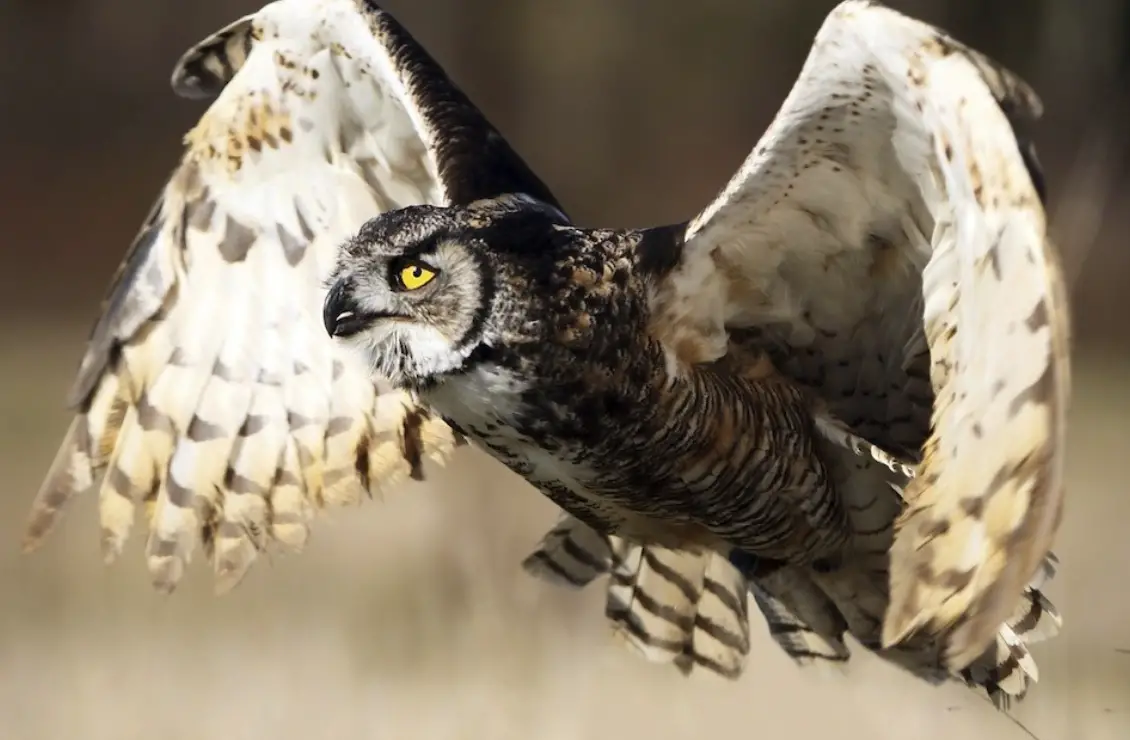Only reputable sources and an Ornithologist were used to gather this information.
Did you know that Louisiana is home to more than 20 different types of owls? These magnificent creatures can be found in all corners of the state, and each one has its own unique characteristics. In this blog post, we will take a closer look at some of the most common owl species in Louisiana. We will discuss their physical features, diet, and habitat. So if you’re interested in learning more about these fascinating animals, keep reading!
Most Common Owls in Louisiana
American Barn Owl

The American Barn Owl is a medium-sized owl measuring between 16-20 inches in length with a wingspan of approximately 36 inches. The body and head of the bird are fairly round with large, dark eyes. The upper parts are light brown to rusty-colored with white spots while the underparts are white with some brown mottling.
There is a dark band across the chest. The facial disk is white with a brown border and there are no ear tufts. Juveniles are similar in appearance to adults but are overall more lightly colored.
This owl is found throughout North America including Louisiana. It prefers habitats near water such as marshes, swamps, bayous, and wooded river bottomlands. The American Barn Owl will also use man-made structures such as barns, silos, and abandoned buildings.
This owl is nocturnal, meaning it is most active at night. During the day, it roosts in a hidden location.
The American Barn Owl hunts by flying low over open areas using its keen hearing to locate prey. It primarily feeds on small mammals such as rats, mice, and voles.
The owl will also eat birds, reptiles, amphibians, and invertebrates. To find food, the American Barn Owl uses a “silent flight” which helps it to sneak up on its unsuspecting prey.

Great Horned Owls
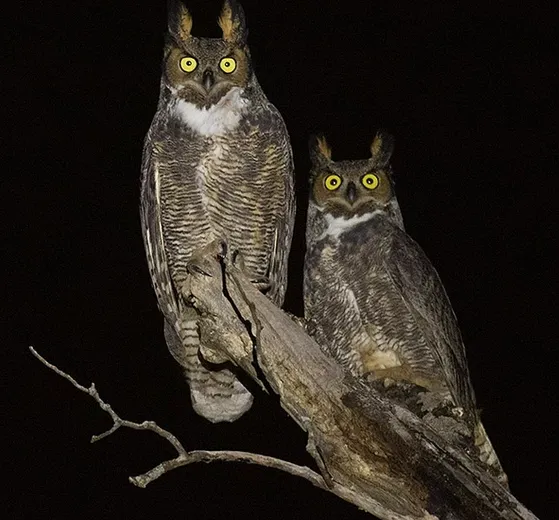
The Great Horned Owl is the largest owl in North America, and one of the most widespread. These owls are easily identified by their large size, prominent ear tufts, and dark eyes. Great Horned Owls are also sometimes called “hoot owls” because of their distinctive call.
Great Horned Owls are found in a variety of habitats, including forests, deserts, and even urban areas. In Louisiana, they are most commonly found in wooded areas near swamps or bayous.
Great Horned Owls are predators, and will eat a wide variety of prey items. Small mammals such as rabbits and rodents make up the majority of their diet, but they will also eat birds, reptiles, and even fish.

Barn Owls
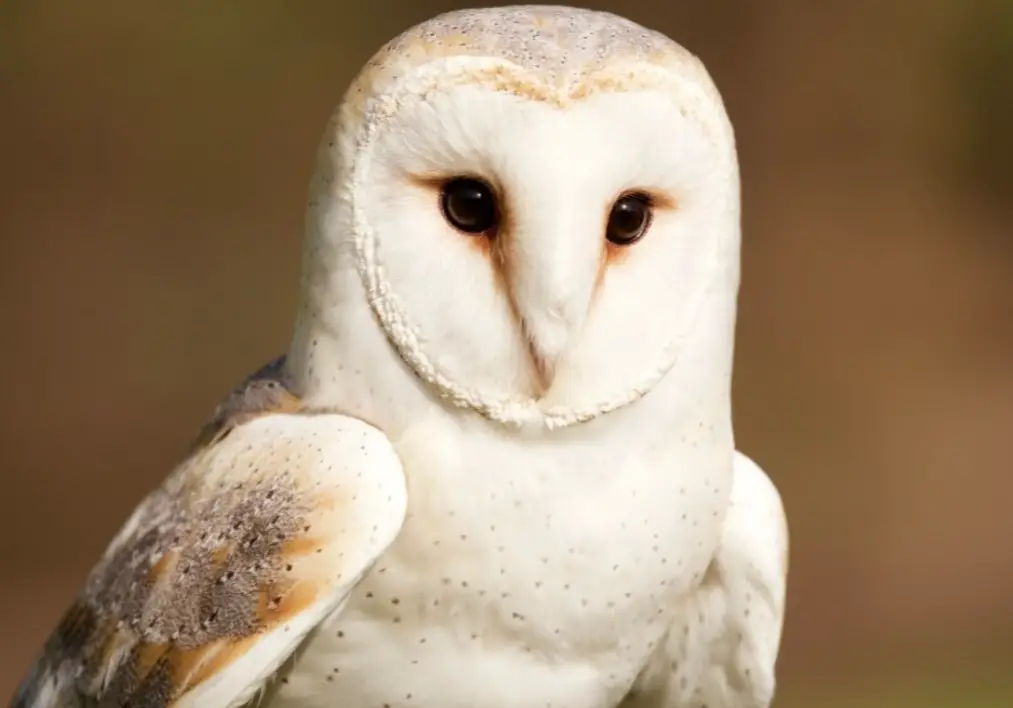
The Barn Owl is a medium-sized owl with a large, rounded head and no ear tufts. It has a black beak, dark eyes, and white facial disks surrounded by black. The upperparts are pale brown with darker streaks, while the underparts are whitish with brownish bars.
The wings are long and have distinctive white patches. The tail is relatively short and square-ended.
This owl gets its name from its habit of roosting in old barns, abandoned buildings, and other man-made structures. It will also use trees, cliffs, and caves when available.
The Barn Owl is found throughout the world except in the polar regions. In North America, it is found in all states and provinces except Alaska and the northernmost parts of Canada.
The Barn Owl is mostly nocturnal, but it will sometimes be active during the day. It hunts over open country for small mammals such as mice, voles, and shrews.
The owl listens for its prey moving about on the ground, then swoops down to catch it with its sharp talons. It will also eat small birds, reptiles, and insects.

Eastern Screech Owl
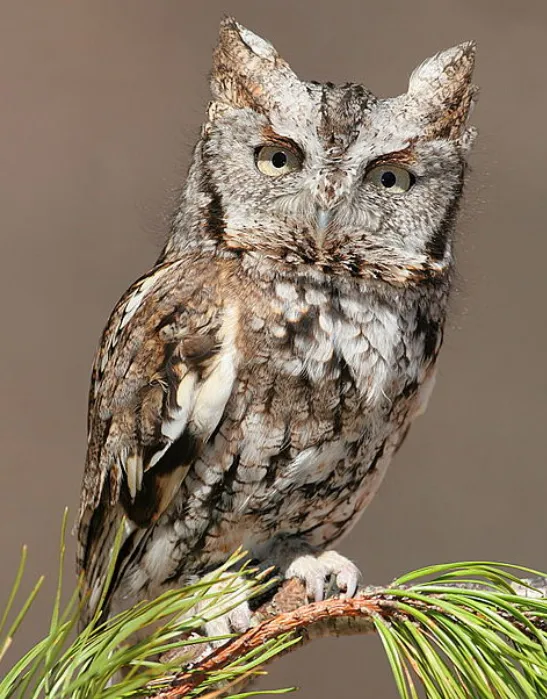
The Eastern Screech Owl is a small owl that is found in the eastern United States. They are nocturnal owls and are most active at night. They have two color morphs, gray and red. The gray morph is more common in the northern part of their range and the red morph is more common in the southern part of their range.
The Eastern Screech Owl is a small owl with a body length of about eight inches. They have large eyes and a round head. Their wings are short and they have a long tail. The Eastern Screech Owl is found in wooded areas near water. They nest in tree cavities and will also use man-made nest boxes.
Eastern Screech Owls eat insects, small mammals, and reptiles. They hunt by perching on a branch and waiting for their prey to come close. They will also fly low over the ground to catch their prey. The Eastern Screech Owl is a non-migratory owl. This means that they stay in the same area throughout the year.
The Eastern Screech Owls are common owls in Louisiana. They can be found in wooded areas and parks throughout the state.

Barred Owl
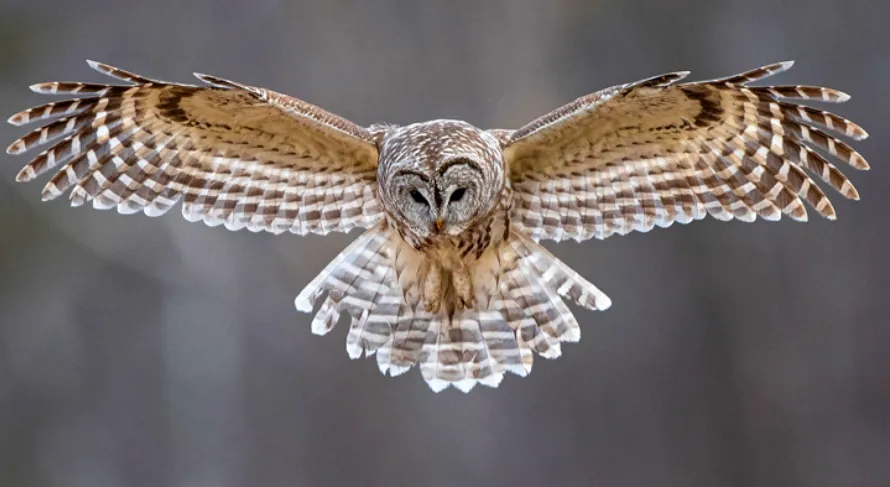
The Barred Owl is a medium-sized owl with a large, round head and no ear tufts. It has dark eyes and a yellow beak. The plumage is brown with white bars on the wings and tail.
Barred Owls are found in wooded areas across North America. In Louisiana, they are most commonly found in the southeastern part of the state. These owls are nocturnal, so they are most active at night. During the day, they roost in trees or on branches.
Barred Owls hunt for small mammals, such as rodents and rabbits. They use their sharp talons to kill their prey. Barred Owls are also known to eat birds, reptiles, and amphibians.
If you see a Barred Owl in Louisiana, it is likely that the bird is hunting for food. These owls are not afraid of humans, so you can get close to them for a better look. Just be sure not to disturb their habitat or scare them away.

Long-eared Owls
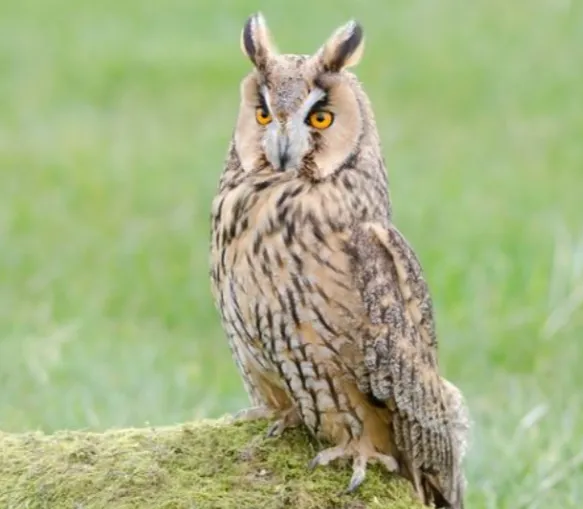
The Long-eared Owl is a medium-sized owl with prominent ear tufts. It ranges in length from 13-17 inches and has a wingspan of 36-42 inches. The upper parts are brown with white spots, while the underparts are pale with heavy brown streaking.
The facial disk is gray with a black border, and the eyes are yellow. The bill is black and the legs and feet are covered in feathers.
Long-eared Owls are found in woodlands, forests, and other habitats with trees. They hunt at night, using their excellent hearing to locate small mammals such as mice and voles.
These owls will also eat birds, reptiles, and insects. Long-eared Owls are relatively quiet, but can sometimes be heard making a soft hooting sound or a series of clicks.
If you see a Long-eared Owl in Louisiana, it is most likely to be found in the northern part of the state. These owls are not common, but they are sometimes seen roosting in trees during the day.

Related post: Types of Owls in Colorado
Burrowing Owls

Burrowing Owl Scientific name: Athene cunicularia
Burrowing owls are small, long-legged owls with a round heads and no ear tufts. They range in size from about seven to ten inches tall and have a wingspan of about two feet.
Burrowing owls are found in open habitats such as prairies, deserts, farmlands, and airports. In Louisiana, they are most often found in the northern part of the state.
Burrowing owls get their name from their habit of nesting and roosting in burrows that they excavate themselves, or that have been abandoned by other animals such as prairie dogs or ground squirrels.
These burrows can be up to six feet deep and may have multiple entrances. Burrowing owls will also use artificial nest boxes.
Burrowing owls are active during the day and at night. They hunt for insects, rodents, and other small animals on the ground.
When hunting, they may perch on a fence post or low branch, or they may hover in the air before swooping down to capture their prey.

Northern Saw-Whet Owl
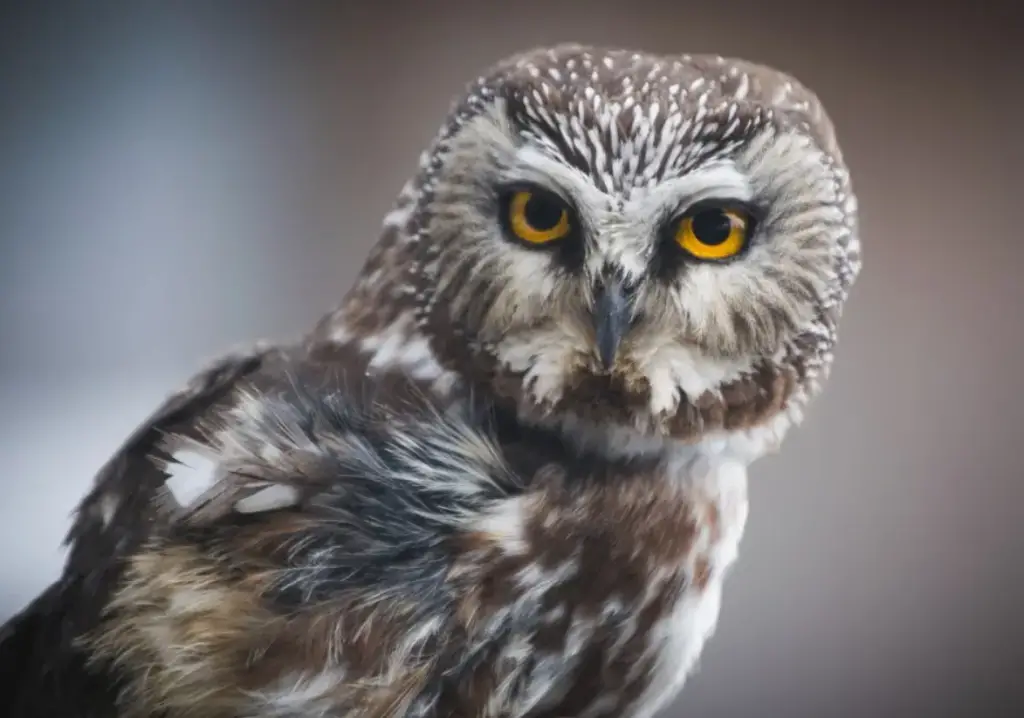
The Northern Saw-whet Owl is a small owl with big eyes. Adults have brown upperparts and white underparts with some brown streaks. Their head is round and lacks ear tufts.
The bill is black, and the facial disk is orange-brown with a white “Y” or “V” mark in the center. Juveniles are similar in appearance to adults, but they have more white on their underparts and face.
This owl is found in coniferous and mixed woodlands across North America. In the summer, they range from Alaska and Canada south to Colorado and New York.
In the winter, they move further south into the United States. They are nocturnal, meaning they are most active at night.

Short-eared Owls
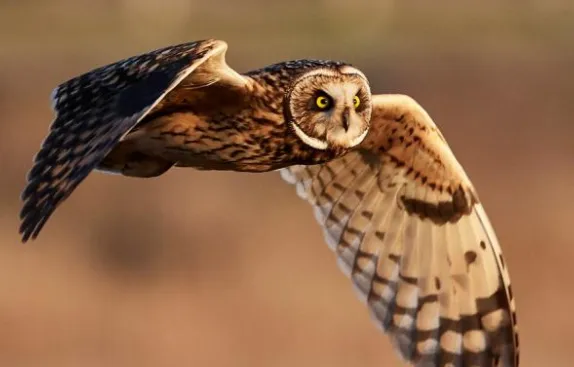
Short-eared Owls are medium-sized owls with a wingspan of about three feet. They have mottled brown and white feathers, and their head is round with no ear tufts. Short-eared Owls are active during the day and night but are most often seen at dawn and dusk.
They hunt over open fields and meadows and prey on small mammals such as voles and mice. In Louisiana, Short-eared Owls are found in the northern and central parts of the state.

What’s the biggest owl in Louisiana?
The Great Horned Owl is the biggest owl in Louisiana. These owls are easily identified by their large size, prominent ear tufts, and dark eyes. Great Horned Owls are found in a variety of habitats, including forests, deserts, and even urban areas.
Is it good to have owls in your yard?
There are a few things to consider before deciding if you want owls in your yard. Owls are predators and can eat small mammals, birds, reptiles, and even fish. If you have pets or small children, you may not want an owl in your yard.
Owls are also nocturnal, so they may make noise at night. If you are a light sleeper, an owl in your yard may not be the best idea.
Owls can also help to control pests in your yard. If you have a problem with rodents or other small animals, having an owl around may help to keep the population under control.
What owls are common in Louisiana?
The most common owls in Louisiana are the American Barn Owl, the Great Horned Owl, and the Barn Owl. These three owls can be found in a variety of habitats across the state.

An avid ornithologist, zoologist and biologist with an unwavering passion for birds and wild animals.
Dr. Wilson’s journey in ornithology began in childhood and led him to obtain a Ph.D. in Ornithology from the prestigious Avian Research Institute. He has worked closely with renowned experts in the field and conducted extensive research and field studies globally.

